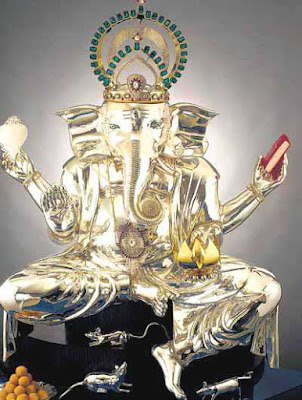आते सबसे पहले बड़े धूम से गणेषजी , जाते भी बड़े धूमसे गणेषजी ....
108 Names of Ganesha and Their Meanings
The 66-feet Chinmaya Ganadhish idol in Kolhapur is at present considered to be the tallest Ganesha idol in the world. The idol sits on 24-feet Dhyana Nilayam (raised platform). Thus the statue is 90 feet from the ground level. This tall Ganapati is a permanent statue unlike the idols created during Ganesh Chaturthi.
The Lord is seated, with a conchshell, the Bhagvad Gita, and a lotus in his hands. His vahan, the mouse, moves around him playfully, and is depicted in multiple positions around him. His crown is embedded with emeralds, while the ornaments are crafted using rubies and other semi-precious stones.
Bada Ganpati Better known for its size than antiquity, this temple houses perhaps the largest Ganesh idol in the world, measuring 25 ft. from crown to foot. Created as a result of a dream to an Avantika ( Ujjain ) resident Shri Dadhich, it was built in 1875. The idol has a most interesting configuration of ingredients: bricks, lime stone, masala made of gud, methi dana, soil collected from seven moksha puris
8 ft tall Sasivekalu Ganesha idol in the ancient ruins of Hemakut hill, Hampi is a famous idol of Lord Ganesha.In Kannada language, sasuwekalu means linseed. One wonders why such a huge idol is called by such a name! Apart from this idol is the Vighnantaka Vinayaka. The uniqueness of this idol is that it is not elephant headed but instead has the head of a man. Vighnantaka Vinayaka killed the demon Gajamukhasura.
Naramukha Ganesha - Ganapatheeshwaram in Tamilnadu.
Dodda Ganesha Temple was constructed in 16th century and is dedicated to a sacred bull – Nandi carved out of a single granite block. situated on Bull Temple Road in Basavanagudi. The temple is a typical specimen of Dravidian architecture. It has a huge monolithic statue of Ganapathi which is about 18ft height and 16ft width. Also known as Shakthi Ganapathi and Satya Ganapathi, this idol of Ganesh is believed to be growing on its right side.
Ice idol of Ganesha - At Amarnath
Amarnath Gumpha: An ice idol of Bal Ganesha is seen here. The Amarnath shrine is located approximately 145 km from Srinagar, 4,175 m above sea level. The path leading to the holy cave of Amarnathji is inaccessible in the winters. This is because from September to June, the weather conditions in the area are extremely hostile and the path remains covered with snow. The Amar Nath pilgrimage tour from Kashmir is possible only in monsoons, i.e. from July to August.The Amarnath yatra holds great significance for the devotees, especially of Lord Shiva. It is believed that an ice Shivalinga forms in the cave of Amarnath in every lunar month. The Shivalinga starts taking shape on the first day of the bright half of the month and forms fully on the full moon day and then begins to dissolve on the no moon day. There are four to five ice figures resembling various deities inside the Amarnath cave. As per the custom, the largest one is believed to be of Amarnath (Lord Shiva), one on its left of Lord Ganesha and ones on the right of Parvati and Bhairava respectively.
Ekadanta Ganesha
Ekadanta is a name of Lord Ganesh, who is said to have broken one of his tusks to write the Mahabharata. Eka means Single and Danta means tooth. Ekdant Ganapati Temple, located in Dhragadhra, Surendranagar. This idol is about 7 ft and is carved in a single stone and has only one tooth. The broken tusk is missing. It is extremely rare to find such an idol.
Shadbhuja Ganesha
Shadbhuja Ganesha temple is located in Baijanath, Kangada. Gnyaneshwar, describes Lord Ganesha in his book Gnyaneshwari and named the six weapons held by Lord Ganesha. The same weapons are found in the hands of this idol of Lord Ganesha.It is a known fact that the number of Ganesha’s arms has always varied from ancient times. His best-known forms have between two and sixteen arms. Many depictions of Ganesha feature four arms, which is mentioned in Puranic sources and codified as a standard form His earliest images had two arms while forms with 14 and 20 arms appeared in central India during the 9th and 10th centuries. The 6 armed Ganesha can also be found in the 32 Forms of Ganesh in Agamic Scriptures. Kshipraprasaada Ganapati, Red colored image of six armed Ganapati. Trimukha Ganapati, Red colored image of Ganesha with three faces and six arms seated on a golden lotus and Ucchishta Ganapati, Blue colored image of six armed Ganapati with his consort.




